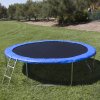I just did some testing of this. Did 5 precision takeoff techniques and tested RTH and landing.
At times it was accurate to within inches, the worst i saw was maybe 1m or so off. This is far more accurate than you'd expect from GPS alone.
The drones behaviour is different - it doesn't reorientate itself to the same as it used to take off when it starts to descend.
Maybe i just got very lucky with a way better than average GDOP so i'll try again but if it was GPS only i wouldn't expect that accuracy level.
At times it was accurate to within inches, the worst i saw was maybe 1m or so off. This is far more accurate than you'd expect from GPS alone.
The drones behaviour is different - it doesn't reorientate itself to the same as it used to take off when it starts to descend.
Maybe i just got very lucky with a way better than average GDOP so i'll try again but if it was GPS only i wouldn't expect that accuracy level.














